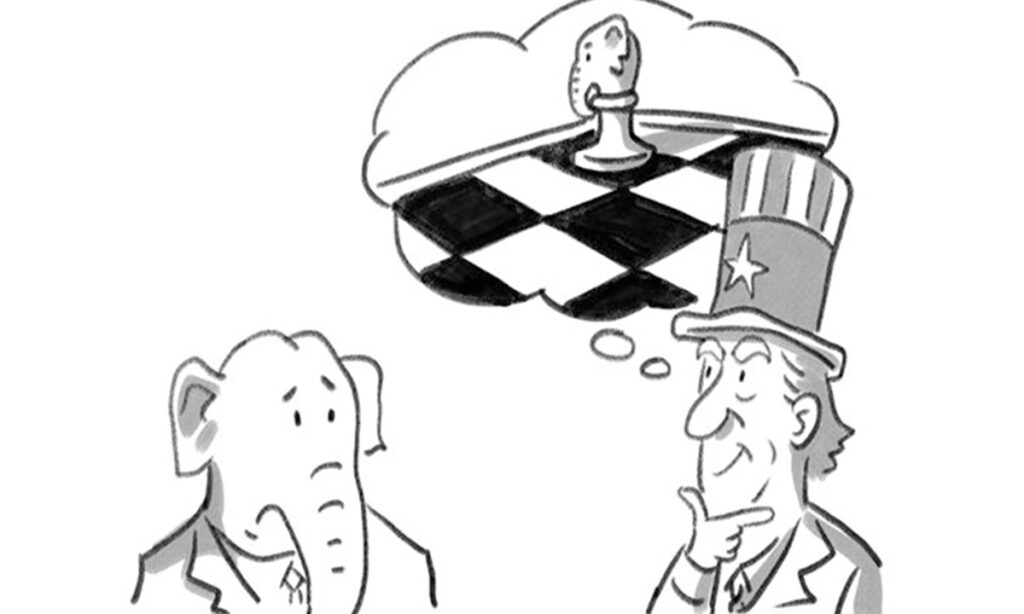The India-US joint military exercise “Yudh Abhyas” is currently underway in Uttarakhand, about 100 kilometers from the Line of Actual Control (LAC) on the India-China border. This year’s drills in Auli were the 18th edition of joint exercises known as “Yudh Abhyas” or “War Practice” that are held alternately in the US and India with the aim of exchanging best practices, tactics, and techniques. The location of this joint military exercise is only about 100 kilometers from the LAC of the border, which has raised suspicions about their intentions.
Choosing this time to conduct military exercises with India, not far from the border between China and India, on the one hand, Washington wants to strengthen military cooperation with India to embolden India to provoke China in a more aggressive manner, which can be said to have a strong implication of instigation. On the other hand, the US displayed high-altitude technologies in the exercises, and it is seeking to demonstrate its determination to support India by exporting even more weapons and equipment to India.
Washington has been trying to push India to join the “anti-China and anti-Russia” camp for a long time, but India has not followed Washington’s lead when it comes to sanctioning Russia. Accordingly, the US recognized that it needed to get India to separate the issue of Russia from the issue of China. Although China and India have relatively large trade exchanges, the border issue between the two countries has yet to be fully resolved, which the US has found to be a grip in undermining the relationship between China and India, in a bid to achieve its ultimate goal of enabling India to collaborate in the full containment of China.
Song Zhongping, a Chinese military expert and TV commentator, told Global Times that the US will not help India confront China; rather, on the contrary, it is precisely hoping that India can help it contain China. Washington hopes that with its assistance in military equipment and intelligence, India will confront China militarily and even engage in an arms race. It is expecting that India will become an important pawn in its Indo-Pacific strategy, and thus India will be able to contain China’s development in the Indo-Pacific region.
“It has to be said that the US is sending the wrong signal to India. It is now providing India with a large number of weapons and equipment, which inflates populist ideology in India and even makes India’s ruling party think that it has military advantages, thus making India a passive object to be exploited. At that time, India may take risks, and there may be a serious confrontation in the relationship between China and India, which the US can profit from.” Song pointed it out.
India hopes to take advantage of extraterritorial forces as leverage in resolving the China-India border dispute. Therefore, it has kept showcasing its weight through playing the US card. India has always wanted to be a major power. To do so it needs US help in boosting its own development, including in the fields of economy and technology. On the other hand, without a doubt, India takes China as its imaginary enemy.
Actions of the US once again show that it is Washington who is a trouble maker and saboteur of regional peace, rather than being the so-called guardian of the rules-based order. In terms of China-related affairs, India should ponder carefully on whether it should have its own firm stance, or should it act as a cat’s-paw of the US, sacrificing itself to help pursue US hegemonic interests. India has always been stressing that it is an independent country. New Delhi should be well aware that inviting US in [the China-India border disputes] is equivalent to inviting disaster by letting in invaders. Worse, it’s easier to invite the devil in than to send him away, Zhang Tengjun, deputy director of the Department for Asia-Pacific Studies at the China Institute of International Studies, told the Global Times.
Now, the US has realized that the international order which was created by itself has changed and its influence is declining. Against the backdrop, Washington wishes to stir up more trouble in Asia-Pacific region to contain China through the help of its allies. And it wants to establish a new set of US-centered economic and political frameworks, so as to change the rules of the games to better suit US future development and maintain its global hegemony.
Washington hopes that India could be such an agent in this regard, it also hopes Japan could act like one as well. It wishes that more Asia-Pacific countries could be US agent. In that case, the US no longer needs to do the dirty works itself. Therefore, both China and other regional countries should be vigilant against Washington’s tactics and avoid becoming the victim of US’ maintenance of global hegemony. The US is not only aimed at China. Its series of moves has also sowed the seeds of future confrontation and conflicts among regional powers, threatening peace and stability for the region.
(Global Times)




